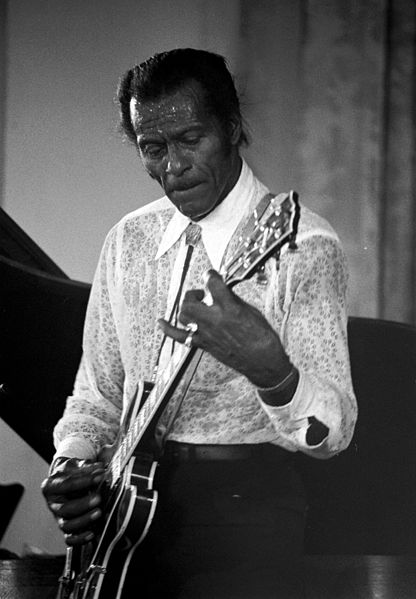An effects unit, effects processor, or effects pedal is an electronic device that alters the sound of a musical instrument or other audio source through audio signal processing.
A pedalboard allows a performer to create a ready-to-use chain of multiple pedals to achieve certain types of sounds. Signal chain order: tuner, compressor, octave generator, wah-wah pedal, overdrive, distortion, fuzz, EQ and tremolo.
Various type of guitar and bass effect pedals.
An example of an effects chain. From the input [right] to the output [left]: Tuner [upper right] (tc electronic Polytune) ⇒ Wah pedal [lower right] (Morley Bad Horsie Wah) ⇒ Overdrives/distortion [lower row] (Rocktron Short Timer Delay → Danelectro CTO-1 Transparent Overdrive → Boss HM-2 → Boss MT-2) ⇒ Modulations/delay [upper row] (Digitech Hyper Phase → Danelectro CV-1 Vibe → Danelectro CT Tremolo → Digitech Hyper Delay)
Rackmounted effects in road cases. These road cases have the front protective panels removed so the units can be operated. The protective panels are put back on and latched shut to protect the effects during transportation.
Distortion and overdrive are forms of audio signal processing used to alter the sound of amplified electric musical instruments, usually by increasing their gain, producing a "fuzzy", "growling", or "gritty" tone. Distortion is most commonly used with the electric guitar, but may also be used with other electric instruments such as electric bass, electric piano, synthesizer and Hammond organ. Guitarists playing electric blues originally obtained an overdriven sound by turning up their vacuum tube-powered guitar amplifiers to high volumes, which caused the signal to distort. While overdriven tube amps are still used to obtain overdrive, especially in genres like blues and rockabilly, a number of other ways to produce distortion have been developed since the 1960s, such as distortion effect pedals. The growling tone of a distorted electric guitar is a key part of many genres, including blues and many rock music genres, notably hard rock, punk rock, hardcore punk, acid rock, and heavy metal music, while the use of distorted bass has been essential in a genre of hip hop music and alternative hip hop known as "SoundCloud rap".

The DS-1 was the first ever distortion guitar effect pedal manufactured by Boss
The guitar solo on Chuck Berry's 1955 single "Maybellene" features "warm" overtone distortion produced by an inexpensive valve (tube) amplifier.
Big Muff fuzzboxes: a NYC re-issue (L) and a Russian Sovtek version (R)
The Boss BD-2 Blues Driver



![An example of an effects chain. From the input [right] to the output [left]: Tuner [upper right] (tc electronic Polytune) ⇒ Wah pedal [lower right] (M](https://upload.wikimedia.org/wikipedia/commons/thumb/4/4a/Anders_pearson%27s_pedalboard_%282010-03-20_11.07.50%29.jpg/640px-Anders_pearson%27s_pedalboard_%282010-03-20_11.07.50%29.jpg)




